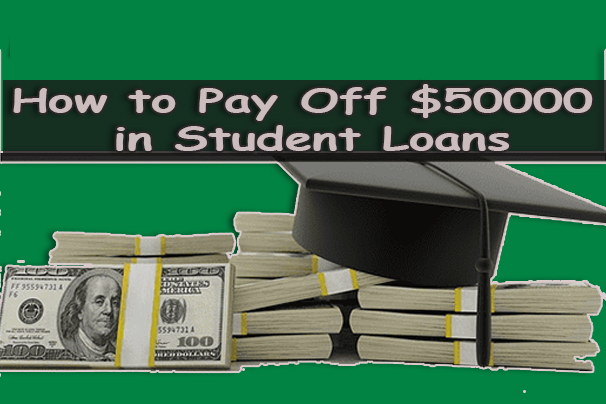How to Pay Off $50000 in Student Loans – Students who recently graduated most times have a hard time paying off their student loans. As the educational sector grows, the cost of tuition and loan sums increases, causing most students to borrow $50000 or more in student loans. How to pay off $50000 in student loans has kept students up at night.

It is not impossible to pay off $50000 if you use the right processes to repay the loan. It may feel like a heavy weight to pay off such an amount of money in student loans. However, there are different repayment methods you can follow to repay the student loans. The fastest means to repay a student loan is to pay more than the minimum loan amount each repayment month. The more you make these payments, the less your interest costs and the faster you get to repay the loan.
6 Ways to Pay Off $50000 in Student Loans
Students who owe $50000 in student loans can follow the six easy methods to repay their loans and get out of debt quickly. Below are six ways to pay off $50,000 in student loans.
Regulate your repayment budget
Create a monthly payment budget to help you keep track of your loan repayment schedule. Review your monthly income and regulate your student loan monthly payment. Hardship assistance is offered by some private lenders to offer assistance with the regulation of your repayment budget. Keep in mind that you need to be eligible first, and eligibility criteria depend on the lender.
Check for Repayment Plan Alternatives
Consider checking other repayment plans to change your student loan term length. Making your repayment term shorter causes an increase in your monthly repayments, while your repayment is decreased if your repayment is shorter. Federal student loan borrowers can apply for an income-driven repayment term that offers payment amounts based on their discretionary income percentage. If you are unemployed, your loan repayment can be as low as $0. Private student loan lenders typically don’t offer income-driven terms, but calculating monthly loan payment budgets may qualify for hardship assistance.
Contemplate Between Refinancing or Consolidation
You can decide to refinance your loan or consolidate your student loan to make repayment easier to do. If you have a private and federal student loan or even just a private loan, refinancing your loan could be a good idea. Refinancing a student loan includes getting a new loan to pay off your existing loan, leaving you with a monthly repayment to your new lender.
Based on your credit history, score, and your current repayment term, your new interest rates are determined. Refinancing student loans may result in lower interest rates or monthly repayments, potentially causing loss of federal protections and benefits. Before proceeding with refinancing your loan, take into consideration the risks attached.
Analyze Forgiveness Options
In some cases, your student loan can be canceled or forgiven. Public service workers are more likely to be eligible for student loan forgiveness. Employers are mandated to assist employees in qualifying for the Public Service Loan Forgiveness program to alleviate their debt. This forgiveness program is different from other one-time forgiveness options. Public service workers such as teachers, nonprofit workers, government employees, and even those with disabilities are likely to qualify for student loan forgiveness. Loan forgiveness is not granted until you make the corresponding 120 payments and payments while your loan is under consideration.
Locate an Employer Willing to Help
Some employers complement student loan contributions to a specific amount, causing an increase in your student loan payment. An example of this is if you are required to pay $50 every month for your loan, your employer may increase it to $100 each month to help you repay the loan sooner than expected. When looking for jobs, check out companies that provide student loan assistance as part of their benefits. You can also ask their employees to confirm if they offer these benefits during your interview.
Try using debt avalanche or snowball methods
Another way to handle your student loan repayment is through debt avalanche and snowball. The debt avalanche method covers debts with higher interest rates; it helps lessen a loan’s additional interest payments. As you pay off your minimum required payment, you are to add extra cash toward a debt with higher interest.
The debt snowball method puts together all your student loans, such as the loan interest rates, minimum payment amount, loan balance, and the loan’s due date. Then you will make the minimum student loan repayment and put the rest of your income into covering up the smallest debt.



